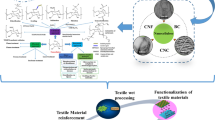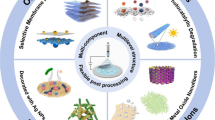Abstract
This work aimed to study the efficiency of nano- and micro- fiber membranes in immobilizing Actinobacillus succinogenes CCTCC M2012036 for succinic acid production. Among the four kinds of electrospun nanofiber membranes of cellulose acetate, chitosan, poly(vinyl alcohol) (PVA) and chitosan-PVA, the cellulose acetate nanofiber membrane-immobilized cells performed the best with a succinic acid concentration and yield to be 27.3 ± 3.5 g/L and 70.9 ± 5.8%. The cell-immobilized viscose microfiber membrane presented good reuse stability, and 17 batches of fermentation without activity loss were realized with the highest succinic acid yield of 83.20%. A microfiber membrane bioreactor was further constructed with the cell-immobilized viscose microfiber membrane to perform fermentation on a larger scale, and the concentration, yield and productivity of succinic acid were 73.20 g/L, 86.50% and 1.49 g/(L⋅h) using a fed-batch strategy, which were 124.30%, 127.60% and 124.2% of those obtained in the traditional fermenter. This study provided an approach for improving the practicality of biological succinic acid production.








Similar content being viewed by others
Data availability
All data generated or analysed during this study are included in this published article.
References
Cok B, Tsiropoulos I, Roes AL, Patel MK (2014) Succinic acid production derived from carbohydrates: an energy and greenhouse gas assessment of a platform chemical toward a bio-based economy. Biofuel Bioprod Biorefin 8:16–29
Luthfi AAI, Tan JP, Harun S, Manaf SFA, Jahim JM (2019) Homogeneous solid dispersion (HSD) system for rapid and stable production of succinic acid from lignocellulosic hydrolysate. Bioprocess Biosyst Eng 42:117–130
Chen Y, Nielsen J (2013) Advances in metabolic pathway and strain engineering paving the way for sustainable production of chemical building blocks. Curr Opin Biotech 24:965–972
Luo L, van der Voet E, Huppes G (2010) Biorefining of lignocellulosic feedstock-technical, economic and environmental considerations. Bioresource Technol 101:5023–5032
Li C, Yang XF, Gao S, Chuh AH, Lin CSK (2018) Hydrolysis of fruit and vegetable waste for efficient succinic acid production with engineered Yarrowia lipolytica. Clean Prod 179:151–159
Delhomme C, Weuster-Botz D, Kuhn FE (2009) Succinic acid from renewable resources as a C4 building-block chemical—a review of the catalytic possibilities in aqueous media. Green Chem 11:13–26
Jiang M, Ma JF, Wu MK, Liu RM, Liang LY, Xin FE, Zhang WM, Jia HH, Dong WL (2017) Progress of succinic acid production from renewable resources: metabolic and fermentative strategies. Bioresour Technol 245:1710–1717
Gao C, Guo L, Song W, Wu J, Chen XL, Liu LM (2022) Advances in microbial engineering for the production of value-added products in a biorefinery. Syst Microbiol Biomanufacturing. https://doi.org/10.1007/s43393-022-00104-9
Jansen MLA, van Gulik WM (2014) Towards large scale fermentative production of succinic acid. Curr Opin Biotech 30:190–197
Anna K, Doris K, Rose M, Eldon RR (2022) Processes for the valorization of food and agricultural wastes to value-added products: recent practices and perspectives. Syst Microbiol Biomanufacturing 2:50–66
Ferone M, Raganati F, Olivieri G, Salatino P, Marzocchella A (2017) Biosuccinic acid from lignocellulosic-based hexoses and pentoses by Actinobacillus succinogenes: characterization of the conversion process. Appl Biochem Biotech 183:1465–1477
Song H, Lee SY (2006) Production of succinic acid by bacterial fermentation. Enzyme Microb Tech 39:352–361
Yang Q, Wu M, Dai ZX, Xin FX, Dong WL, Ma JF, Jiang M, Zhang WM (2019) Comprehensive investigation of succinic acid production by Actinobacillus succinogenes: a promising native succinic acid producer. Biofuel Bioprod Biorefin 14:950–964
Corona-González RI, Miramontes-Murillo R, Arriola-Guevara E, Guatemala-MoralesG TG, Pelayo-Ortiz C (2014) Immobilization of Actinobacillus succinogenes by adhesion or entrapment for the production of succinic acid. Bioresour Technol 164:113–118
Cao WF, Wang YJ, Luo JQ, Yin JX, Xing JM, Wan YH (2018) Succinic acid biosynthesis from cane molasses under low pH by Actinobacillus succinogenes immobilized in luffa sponge matrices. Bioresour Technol 268:45–51
Ercole A, Raganati F, Salatino P, Marzocchella A (2021) Continuous succinic acid production by immobilized cells of Actinobacillus succinogenes in a fluidized bed reactor: entrapment in alginate beads. Biochem Eng J 169:107968
Alexandri M, Papapostolou H, Stragier L, Verstraete W, Papanikolaou S, Koutinas AA (2017) Succinic acid production by immobilized cultures using spent sulphite liquor as fermentation medium. Bioresour Technol 238:214–222
Bumyut A, Champreda V, Singhakant C, Kanchanasuta S (2022) Effects of immobilization of Actinobacillus succinogenes on efficiency of bio-succinic acid production from glycerol. Biomass Convers Bior 12:643–654
Stevens MM, George JH (2005) Exploring and engineering the cell surface interface. Science 310:1135–1138
Wang X, Yomano LP, Lee JY, York SW, Zheng H, Mullinnix MT, Shanmugam KT, Ingram LO (2013) Engineering furfural tolerance in Escherichia coli improves the fermentation of lignocellulosic sugars into renewable chemicals. P Natl Acad Sci USA 110:4021–4026
Liu F, Wang M, Wang X, Wang PF, Shen WH, Ding SY, Wang YG (2018) Fabrication and application of nanoporous polymer ion-track membranes. Nanotechnology 30:052001
Wang XF, Hsiao BS (2016) Electrospun nanofiber membranes. Curr Opin Chem Eng 12:62–81
Zheng P, Zhang K, Yan Q, Xu Y, Sun ZH (2013) Enhanced succinic acid production by Actinobacillus succinogenes after genome shuffling. J Ind Microbiol Biotechnol 40:831–840
Chen PC, Zheng P, Ye XY, Ji F (2017) Preparation of A. succinogenes immobilized microfiber membrane for repeated production of succinic acid. Enzyme Microb Tech 98:34–42
Mokwatlo SC, Nicol W, Brink HG (2021) Internal mass transfer considerations in bioflms of succinic acid producing Actinobacillus succinogenes. Biochem Eng J 407:127220
Urbance SE, Pometto AL, DiSpirito AA, Denli Y (2004) Evaluation of succinic acid continuous and repeat-batch biofilm fermentation by Actinobacillus succinogenes using plastic composite support bioreactors. Appl Microbiol Biotechnol 65:664–670
van Heerden CD, Nicol W (2013) Continuous succinic acid fermentation by Actinobacillus succinogenes. Biochem Eng J 73:5–11
Maharaj K, Bradfield MFA, Nicol W (2014) Succinic acid-producing biofilms of Actinobacillus succinogenes: reproducibility, stability and productivity. Appl Microbiol Biotechnol 98:7379–7386
Yan Q, Zheng P, Tao ST, Dong JJ (2014) Fermentation process for continuous production of succinic acid in a fibrous bed bioreactor. Biochem Eng J 91:92–98
Kim MI, Kim NJ, Shang L, Yong KC, Chang HN (2009) Continuous production of succinic acid using an external membrane cell recycle system. J Microbiol Biotechnol 19:1369–1373
Ercole A, Raganati F, Salatino P, Marzocchella (2021) A continuous succinic acid production by immobilized cells of Actinobacillus succinogenes in a fluidized bed reactor: entrapment in alginate beads. Biochem Eng J 169:107968
Luthfi AAI, Tan JP, Isa NFAM, Bukhari NA, Shah SSM, Mahmod SS, Jahim JM (2020) Multiple crystallization as a potential strategy for efficient recovery of succinic acid following fermentation with immobilized cells. Biochem Eng J 43:1153–1169
Acknowledgements
The authors are grateful to the financial support from the Open Project of Key Laboratory of Industrial Biotechnology, Ministry of Education, Jiangnan University (Grant No. KLIB-KF202205) and the National Natural Science Foundation of China (Grant No. 21604032).
Author information
Authors and Affiliations
Corresponding author
Ethics declarations
Conflict of interest
The authors declare that they have no conflict of interest.
Additional information
Publisher's Note
Springer Nature remains neutral with regard to jurisdictional claims in published maps and institutional affiliations.
Supplementary Information
Below is the link to the electronic supplementary material.
Rights and permissions
Springer Nature or its licensor (e.g. a society or other partner) holds exclusive rights to this article under a publishing agreement with the author(s) or other rightsholder(s); author self-archiving of the accepted manuscript version of this article is solely governed by the terms of such publishing agreement and applicable law.
About this article
Cite this article
Chen, PC., Zhang, YD., Ye, XY. et al. Immobilization of Actinobacillus succinogenes on nano- and micro-fiber membranes for efficient and robust production of succinic acid. Bioprocess Biosyst Eng 46, 611–620 (2023). https://doi.org/10.1007/s00449-023-02848-7
Received:
Accepted:
Published:
Issue Date:
DOI: https://doi.org/10.1007/s00449-023-02848-7




